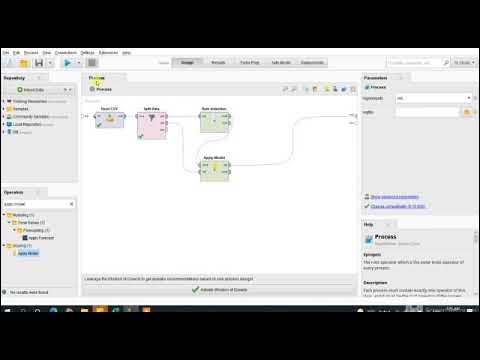Python Machine Learning Tutorial | Splitting Your Data | Databytes
Summary
TLDRThis tutorial explains the essential technique of splitting a dataset into training and testing sets in machine learning. It highlights the risks of overfitting and the importance of testing models on unseen data. The script covers how to prepare and preprocess data, including handling categorical variables with one-hot encoding. It demonstrates the use of Python libraries like pandas and scikit-learn to split data effectively, while also discussing how to control the randomness of the split for reproducibility. The tutorial uses a loan application dataset as an example to illustrate these concepts.
Takeaways
- 😀 Splitting data into training and testing sets is crucial to evaluate how well a machine learning model will perform on unseen data.
- 😀 Training a model on the entire dataset can lead to overfitting, making the model perform well on the training data but poorly on new data.
- 😀 It's important to split your data before feature engineering to avoid data leakage, where information from the test set contaminates the training process.
- 😀 The `train_test_split` function from scikit-learn is commonly used to split data into training and testing sets.
- 😀 A typical split ratio is 75% for training data and 25% for testing data, though you can adjust this based on dataset size.
- 😀 Data preprocessing includes handling categorical variables (like 'purpose') by applying one-hot encoding, turning them into numeric columns.
- 😀 Variable unpacking allows you to store the results of the `train_test_split` function into separate variables for easy access.
- 😀 The `train_test_split` function by default shuffles the data randomly, which can be controlled using the `random_state` argument to ensure reproducibility.
- 😀 You can experiment with different test sizes using the `test_size` argument to adjust the proportion of training and testing data.
- 😀 Ensuring reproducibility of results is important when testing and debugging a model, and can be achieved by setting a random seed via `random_state`.
Q & A
Why is it important to split your dataset into a training set and a testing set?
-Splitting your dataset is crucial because it helps avoid overfitting, ensuring the model is evaluated on data it hasn't seen during training. Without this, the model may perform well on the training set but poorly on new, unseen data.
What problem occurs if you train your model on the entire dataset?
-Training your model on the entire dataset leads to overfitting, where the model becomes too tailored to the training data, causing it to perform poorly on new data.
When should you split the data in a machine learning workflow?
-Data should be split into training and testing sets after feature engineering. Splitting the data too early can lead to data leakage, where information from the test set inadvertently influences the training set.
What is data leakage, and why is it problematic?
-Data leakage occurs when information from the test set leaks into the training set, which can give a false sense of model accuracy and lead to misleading performance results.
What type of data is being used in this tutorial for the splitting process?
-The tutorial uses a loan application dataset that contains various features, with a target variable named 'credit.policy', which indicates whether the loan application met the criteria.
How do you handle categorical data like the 'purpose' column in this dataset?
-Categorical data, such as the 'purpose' column, is handled through one-hot encoding using `pd.get_dummies()`, which converts the categorical values into binary columns representing each category.
What function is used to split the dataset into training and testing sets?
-The `train_test_split()` function from scikit-learn is used to split the dataset into training and testing sets.
What is the default split ratio between the training and testing sets?
-By default, `train_test_split()` splits the data into 75% for training and 25% for testing.
How can you adjust the ratio between the training and testing sets?
-The ratio can be adjusted using the `test_size` argument in the `train_test_split()` function. For example, setting `test_size=0.2` will result in 80% of the data being used for training and 20% for testing.
What is the purpose of setting a random seed with the `random_state` argument?
-Setting a random seed with the `random_state` argument ensures that the data split is reproducible. This means that every time the code is run, the split will be the same, which is useful for debugging and ensuring consistent results in reports.
Outlines

This section is available to paid users only. Please upgrade to access this part.
Upgrade NowMindmap

This section is available to paid users only. Please upgrade to access this part.
Upgrade NowKeywords

This section is available to paid users only. Please upgrade to access this part.
Upgrade NowHighlights

This section is available to paid users only. Please upgrade to access this part.
Upgrade NowTranscripts

This section is available to paid users only. Please upgrade to access this part.
Upgrade NowBrowse More Related Video

Project 06: Heart Disease Prediction Using Python & Machine Learning

RapidMiner - Klasifikasi Iris

Prepare your dataset for machine learning (Coding TensorFlow)

K Fold Cross Validation | Cross Validation in Machine Learning

SKLearn 13 | Naive Bayes Classification | Belajar Machine Learning Dasar

Building Decision Tree Models using RapidMiner Studio
5.0 / 5 (0 votes)